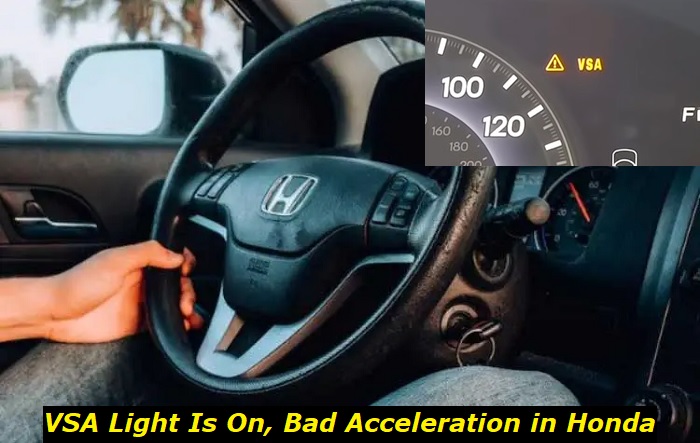A vehicle's stability and smooth drive are crucial to its proper handling. Honda's VSA lights are a critical warning about your car's stability that you should pay attention to. There are moments when your Honda VSA lights come on, especially in certain driving conditions. So, what does the VSA light mean? How can it be fixed?
VSA light highlights
- Common reasons:any issue with the VSA system
- How to fix:disconnect the battery for some time, read the codes
- Possible consequences:safety issues
- Priority level:High
- Can you drive?Not recommended
- DIY repair:Impossible
- Repair price range:$150-$550

What Is The Purpose of The VSA System in Cars?
The Vehicle Stability Assist (VSA) system is a technology that provides safety to drivers. This system helps prevent oversteering or understeering, especially on slippery or icy surfaces. VSA systems are common in most models of Honda and Acura vehicles.
Many accidents have come from poor car handling, and this VSA technology aims to ensure smooth driving in certain conditions. With this system functioning well, it will be difficult for the vehicle to deviate from its actual direction.
How Does The Honda VSA System Work?
The system's sensors activate the light when there is a problem with the car's stability. This happens when the car corners too fast; or the driver oversteers/understeers. VSA also comes into play when you drive on loose terrain.
VSA systems in these situations ensure that the tires are given more traction and grip that put the car under better control. This process happens when each wheel gets a change in its engine output as a result of the automatic measure from the VSA system.
Although this system uses sensors and automatically detects issues, turning it in can be manual. That means you can use buttons to turn on and off the system when necessary.
When a VSA light is on, it happens as a result of a few different situations. Several light indications tell precisely what issue the system has detected. They include:
1) Blinking VSA Light On Console
When you notice a blinking VSA light on the console, it does not indicate a significant problem. Instead, it tells you that the VSA system is assisting your vehicle to steer correctly. You will notice a few changes when this happens. Some of the signs include;
- The accelerator may apply engine power lower than usual
- Also, engine output may dip in some cases.
- The system may also apply an automatic brake to the wheels of your vehicle. However, the driver might not notice the effect of this action.
Any of these signs show that the vehicle is trying to ensure the car is steered safely.
2) VSA Activation Light
Another way this system works is when you see the permanent VSA activation light. At this point, the light comes on and stays lit rather than blinking. This action happens when the console switch in the system is turned off. You can turn it back on to make the light disappear.
Several models of Honda and Acura cars have a button where they activate/deactivate this system. You must check your vehicle's manual to know if there is a VSA button.
3) VSA System Indicator Light
The second VSA indicator light is something that you should not forget. This VSA system indicator light comes on when there is a problem. If you notice that this light comes on and stays lit while driving, the best decision is to pull over and find the possible problem.
You can try shutting the engine down and turning it on back to see if the light is still on. If your VSA indicator light remains on, you must drive more cautiously. At this point, the system cannot safely steer your car when navigating poor surfaces.
What Are the Common Problems With the VSA Systems?
The VSA system can help to ensure a safe driving experience on certain surfaces. But this system can also have failures and malfunctions. Some of the common issues with the VSA systems come from the following:
- Installing the wrong tires/sizes of tires
- Malfunction in the car's Electronic Control Unit (ECU)
- Failure in the brake pedal position sensors.
- VSA systems can also have problems due to the soiling of the wheel speed sensors.
These issues are common causes of failure in your Honda's VSA system. The easy way out here is running diagnostic tests and looking for possible signs of malfunctions within its components.
How Do You Know If Your VSA System Is Malfunctioning?
The VSA system usually has different indicators for different problems. So, it is likely that the appropriate indicator light will come on when you have a faulty VSA system. For example, a blinking VSA light does not call for any worry with the system. However, when only the second VSA console light comes on, there might be an issue with the system itself.
An issue with the system might be due to several reasons. These could include faulty ABS units; wrong or low-pressure tires; malfunctioning components; and even problems with the brake position sensors.
If you suspect a problem with your Honda's VSA system, you should visit a professional mechanic to check it.
It is essential to know how this system works to ensure that you know when the system detects a problem. You have to pay attention to every indicator that this system shows, which can help you know when it is safe to drive.
What Causes The Honda VSA Light To Come On?
You would see the VSA light appear on your dashboard for several reasons. This light can indicate different things. Whether it blinks or stays lit up, there is always a reason for the VSA light turning on. Let us look at five reasons your Honda's VSA might come on.
1) An Issue With The ABS Unit
One of the reasons your Honda's VSA light turns on is due to a fault in the ABS unit. This antilock braking system (ABS) ensures the wheels do not lock when cornering difficult angles. It also prevents your vehicle from deviating from its trajectory and crashing.
Problems with this component could come from failed ABS control module or wheel speed sensors. Faulty ABS regulator rings or sensor wiring can also cause the VSA light to come on.
2) Low Tire Pressure
Another critical aspect of a car's stability is the tires. Low tire pressure can lead to stability problems with your vehicle. Keeping your tires at the correct pressure is very critical to the stability of your vehicle.
A drop in the pressure of your tires will cause them to spin at different speeds. And that can make your VSA light come on as it will detect a stability problem. Choosing the wrong tires can also result in this light turning on. You must always use Honda's recommended tires on your automobile to avoid this problem.
3) VSA Switch on Dashboard Turned Off
Some Honda models have a button to turn on and off the VSA system. If the VSA light comes on, there is a possibility you might have manually turned off the system with the button. Another case might be that you have accidentally pressed the button, and the system light is turning on to indicate the system is off.
Although some people prefer to off the system in certain driving situations, paying close attention to the lights on your dashboard is essential.
How to Fix VSA Light on Honda Models
If you notice that your VSA light is on and stays lit, you do not have to worry. Sometimes, it might not be as severe as you think. However, here are some quick fixes to turning off the VSA light:
- Turn on the VSA system as sometimes it is located that is susceptible to being pressed accidentally.
- Inspect your car's tires and inflate them to correct the tire pressure if there is a drop.
- Your code scanners are another effective device to help you detect VSA system problems. You can start by finding a compatible code scanner, resetting it, and reading the information to identify the issue.
- In some cases, the steering angle and wheel speed sensors might cause problems in this system. In that case, you should replace them immediately.
- The wiring or connections can be the cause of the light turning on. Regardless, after all these diagnostics, the best option from here is to visit an expert mechanic to check it.
Wrapping Up
The Honda VSA system is an effective way to ensure safe driving and handling of your car. When the VSA light comes on, it does so for one of a few reasons. One of the causes of this light turning on might indicate that the system is steering you safely and maintaining the vehicle's stability in certain terrains.
This VSA light can also mean the computer has identified a problem in the VSA system. Although this light would not lead to poor acceleration most times, it subtly applies brakes to the wheels if necessary.
In conclusion, Honda VSA lights indicate that the system helps stabilize the car when you oversteer or understeer.
About the authors
The CarAraC research team is composed of seasoned auto mechanics and automotive industry professionals, including individuals with advanced degrees and certifications in their field. Our team members boast prestigious credentials, reflecting their extensive knowledge and skills. These qualifications include: IMI: Institute of the Motor Industry, ASE-Certified Master Automobile Technicians; Coventry University, Graduate of MA in Automotive Journalism; Politecnico di Torino, Italy, MS Automotive Engineering; Ss. Cyril and Methodius University in Skopje, Mechanical University in Skopje; TOC Automotive College; DHA Suffa University, Department of Mechanical Engineering






Add comment